Are you a Quiet Speculation member?
If not, now is a perfect time to join up! Our powerful tools, breaking-news analysis, and exclusive Discord channel will make sure you stay up to date and ahead of the curve.
Zendikar Rising has had a notable effect on Modern, but it's been mostly positive. Whether it's making Death and Taxes finally viable or shaking up the Prowess decks, the new additions seem to be providing the right incentives without being oppressive. However, one card is drawing ire, mostly by association rather than anything it's actually done.
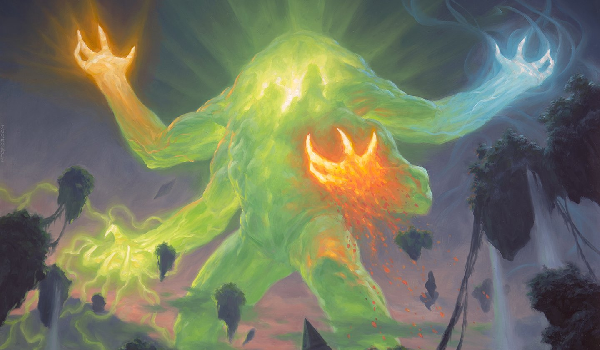
When Omnath, Locus of Creation was banned in Standard, I expected it to surge in Modern. That's usually just how it goes; when something gets banned in Standard, players don't want to give up on their cards, and try them in other formats. Omnath was an easier fit since it had already made some inroads, and with it being banned off Arena there really wasn't any other option. I haven't seen Omnath in Legacy, and Pioneer is... not thriving. That said, I haven't been too impressed by Omnath decks. I can see why players would be drawn to them and appreciate their power. However, they have a fundamental flaw that is easily exploitable.
The Card in Context
Granted, Omnath is far from a bad card. Omnath stands as a monument to ill-considered, all-upside, power-for-free card design that has plagued Magic (and caused an absurd number of Standard bannings) over the past few years. Seriously, did a 4/4 with a ridiculous landfall ability need to draw a card too? However, context is everything, and Omnath's Modern power is much lower than in Standard. Despite being easier to trigger thanks to the fetchlands, Omanth's stats and mana cost aren't anything special in Modern. Niv-Mizzet Reborn is just a mana more for flying, two additional points of power and toughness, and more upfront card advantage. And besides some lower-level league finishes, he's barely done anything in Modern.
 The problem is that Standard is far slower than Modern and has worse answers. This let Omnath sit on the board more often and accrue value. Or, even better, take advantage of weak aggro decks and let Omnath hang out in hand until the time was optimal to cast it, play a land to trigger the lifegain, follow up with Fertile Footsteps, trigger the mana ability, then end the game with Escape to the Wilds. Modern's aggro decks kill on turn four and usually have some kind of disruption, so the optimal Omnath line isn't possible. And this isn't counting how much harder four-color decks have it in a format with Blood Moon and freshly divorced from Arcum's Astrolabe.
The problem is that Standard is far slower than Modern and has worse answers. This let Omnath sit on the board more often and accrue value. Or, even better, take advantage of weak aggro decks and let Omnath hang out in hand until the time was optimal to cast it, play a land to trigger the lifegain, follow up with Fertile Footsteps, trigger the mana ability, then end the game with Escape to the Wilds. Modern's aggro decks kill on turn four and usually have some kind of disruption, so the optimal Omnath line isn't possible. And this isn't counting how much harder four-color decks have it in a format with Blood Moon and freshly divorced from Arcum's Astrolabe.
Thus, Omnath's supporting cast needs to be far better in Modern than Standard. And it certainly looks that way. Fetchlands aside, Uro, Titan of Nature's Wrath is legal, and so is Wrenn and Six to keep the lands flowing. Then there's the much better creature removal to buy time to set Omnath up. On paper, things look promising to the point that some are already saying that Omnath's busted here, too.
Omnath in Practice
However, what's true in theory doesn't matter. Only practice matters, and despite appearances, the Omnath shells aren't impressing me. I've been playing DnT on MTGO, hitting various types of value Omnath decks, and winning fairly easily. I've also proxied up the deck and tested it against Humans and UW Stoneblade, and it doesn't do anything special. It's not awful, but it certainly doesn't seem bannable. For reference, I've been testing against this list:
4-Color Uro, bbotonline (League 5-0)
There is quite a bit of variation between lists, but bbotonline's list is representative. All the value Omnath lists have a full set of Uro with 2-3 Omnath. They tend to have 3 Wrenn and Six, with 2-4 other planeswalkers (4 being most typical). bbotonline switched the Jace, the Mind Sculptor that most lists run for Felidar Retreat, and Teferi, Hero of Dominaria for another Hour of Promise.
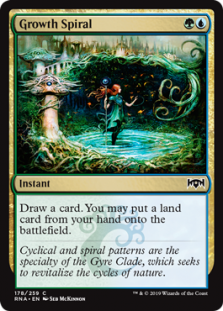 The only ramp comes from 2 Growth Spirals. The rest of the spells are interactive, with the only constants being 4 Path to Exile. Everything else is negotiable or a metagame call.
The only ramp comes from 2 Growth Spirals. The rest of the spells are interactive, with the only constants being 4 Path to Exile. Everything else is negotiable or a metagame call.
This applies to the sideboard as well. Every value Uro deck that I've seen in October is running 29 lands. This is not, as one might expect, to make it easier to cast all the colored spells. In my experience, it actually has the opposite effect. No, the manabase is entirely bent towards maximizing Field of the Dead. I would go so far as to argue that these decks aren't Uro decks so much as Field ones. Uro's just a great setup card. In that light, bbotonline's Retreat makes more sense than the alternatives, as it serves as a castable Field.
The Essence of Durdle
And this all leads into the data I've collected. I don't have exact numbers for my online play, but I know that I have a very positive record against 4-Color Uro on MTGO. It's pretty devastating for a deck that's all about fetchlands to face Leonin Arbiter, but Thalia is also surprisingly strong. 4c Uro really needs to hit its curve, and Thalia is actually a significant burden (Growth Spiral for 3 mana?). Skyclave Apparition also exiles all the relevant permanents, so it's a very good matchup. As for the testing results, those are also not good for 4-Color Uro. Humans is currently sitting at 16 wins in 18 matches, while Stoneblade is 9 for 15. That's not broken deck territory.
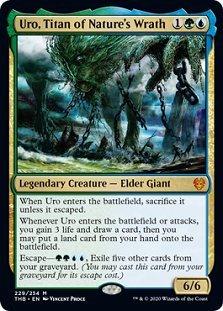 The problem is that the four-color value lists, whether this Field/Uro centric or not, are massively durdly. To the point of actively doing nothing a lot of the time. In testing, Uro's had to mulligan very aggressively for hands that did anything. I'm not even talking about curving well, I literally mean that a lot of hands I've pulled have just done squat, playing a turn 3 Uro at most. Most of the problem is that the deck is exactly 48.3% lands. Most hands will be mostly lands by simple math.
The problem is that the four-color value lists, whether this Field/Uro centric or not, are massively durdly. To the point of actively doing nothing a lot of the time. In testing, Uro's had to mulligan very aggressively for hands that did anything. I'm not even talking about curving well, I literally mean that a lot of hands I've pulled have just done squat, playing a turn 3 Uro at most. Most of the problem is that the deck is exactly 48.3% lands. Most hands will be mostly lands by simple math.
The problem is made worse by so many of the spells being contextual, most prominently the counters. However, almost every permanent is an investment card. Given time, it will pay off, but the immediate impact is low. It's very easy for these 4c Uro decks to run out of gas simply because they don't have much to begin with. Unless they're rolling with Uro chains, there's just no force to them.
Feet of Clay
The manabase problem is actually much worse than just constant flood. As previously mentioned, it's actually quite difficult to cast all the colored spells thanks to the ridiculous curve and all the singleton lands. The ideal goldfish curve, as far as I can tell, is turn 2 Wrenn, turn 3 Uro with land drop, turn 4 Omnath, play fetchland, crack fetchland, use the five mana for Hour of Promise. This requires RG, then 1UG, and WURG, which means that a lot of 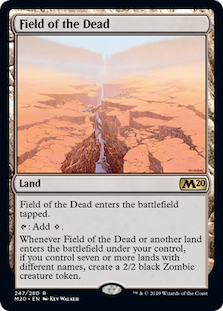 thought must go into each fetch because, doing it even slightly wrong will severely constrain available mana down the line. And that's not getting into the additional calculations for Cryptic Command and Mystic Sanctuary. This is a deck that wants to and must hit every land drop perfectly.
thought must go into each fetch because, doing it even slightly wrong will severely constrain available mana down the line. And that's not getting into the additional calculations for Cryptic Command and Mystic Sanctuary. This is a deck that wants to and must hit every land drop perfectly.
And that's the problem. Uro plays 10 fetchlands and 2 Field of Ruin for fixing. That's less than half the lands in the deck, which means that it's more likely to end up with a hand without a fetchland unless you mulligan aggressively. Just keeping lands and spells is deadly for this deck because there is an alarmingly high chance that the lands in hand won't actually cast all the spells. Any stability or redundancy in the manabase has been sacrificed to maximize the odds of activating Field of the Dead. If the deck can't fetch for a Triome turn 1, it's already falling behind.
There is a Reason
Given all these problems, it would be tempting to just write the deck off as the latest value-town pile. However, this is tempered by the knowledge of how devastating it is when 4c Uro actually does go turn 2 Wrenn, turn 3 Uro with land drop, turn 4 Omnath, play fetchland, crack fetchland, use the five mana for Hour of Promise. That's an absurd amount of card advantage, board presence, and life swings. Combo as always doesn't care, but it's utterly devastating for any fair deck to try and fight through. It also just feels amazing to pull off and  makes you dream about crushing opponents that thoroughly again. Which is my explanation for the deck's popularity; gotta chase that high (variance sequence).
makes you dream about crushing opponents that thoroughly again. Which is my explanation for the deck's popularity; gotta chase that high (variance sequence).
This also frustrates me. The basic sequence of Wrenn, Uro, and Omnath is pretty overwhelming value-wise on its own. Continuing onto Field is crushing, but more akin to piling on. I can't suppress the thought that a lot is being sacrificed to Field when it doesn't need to be. Retreat is a perfectly serviceable analogue that doesn't require contorting the manabase. It constantly feels like the deck is deliberately choosing to lose a lot of fast games in order to dominate the long ones. It's why it's losing badly to Humans and DnT but faring much better against Stoneblade. It takes that perfect curve to keep up with Humans (unless Uro draws all the Paths, and sometimes not even then) but unless Stoneblade has Stoneforge Mystic on turn 2, it has no pressure. This lets Uro durdle to its heart's content, which is how it wins. But again, it feels like it doesn't have to and could be better if it didn't lean into durdling so much.
An Improvement
I'm not the only one who thinks so. Last week, kanister won a challenge playing Copycat with Omnath, and others have followed. The metagame data is inconclusive, but I can say that last week was the best 4-Color Copycat (or even Jeskai Copycat) has had since I started watching MTGO data. It's always had a presence, but never climbed past Tier 3. Since kanister's win, it has starting stealing slots from the typical Uro lists. And I think that it should completely replace them.
Omnath Saheeli, PATXI (League 5-0)
Jordan's already gone into detail about the deck. The main takeaway is that adding Omnath to 4-Color Copycat has been complimentary. Copycat was already running Wrenn and Uro, but really needed to build into something better than a Felidar Guardian (assuming it didn't just combo). The same value snowball, but with a way to acutally win the game outright? Sounds like a very sweet deal.
The Key
The biggest plus is the manabase. Yes, it is still mostly singletons. But this time there's some slack being cut. With 12 actual fetchlands in a 25-land deck, the fetch density is much higher than in the value Uro deck. Plus, with no colorless utility lands, the deck is far less likely to just 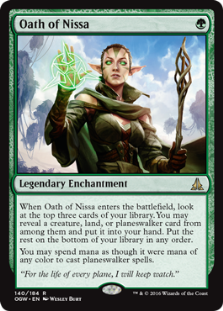 splutter out due to unreachable color requirements. Copycat doesn't have to get a Triome first then hit another fetch or die every game! That alone is reason to switch.
splutter out due to unreachable color requirements. Copycat doesn't have to get a Triome first then hit another fetch or die every game! That alone is reason to switch.
Better, the deck can actually solve its in-game manabase woes. In Uro, the only hope for awkward mana was to Wrenn back fetchlands or get a lucky draw. Copycat has 8 ways to fix mana, between Oath of Nissa and Utopia Sprawl. So long as it has a green source, Copycat can actually get out of color screw on purpose, rather than just by randomly drawing the right card. This adds a robustness to the mana which means that in my (so far limited) testing there are far fewer free wins thanks to hopeless color requirements. Making me actually work for wins more often is a huge win in and of itself.
Twin's Shadow
Copycat has always been a very pale shadow of Splinter Twin in Modern. That whole instant-speed combo thing leaves imitators anemic, but Copycat has the additional problem of being more cost-intensive and less interactive than Twin was. This has always made it a fringe deck. In truth, a lot of the problems are still present. Copycat hasn't magically become a Tier 1 powerhouse just by adding Omnath. However, it is better now, and certainly feels more threatening to play against while being less frustrating than other 4-Color Uro/Omnath decks. There's some actual potential here, and I couldn't say that before Omnath. Keep an eye on Copycat.




Great read, David, thanks!
It seems that the consensus is that modern is in decent shape. Diversity seems to ne the order of things. And new decks are taking the stage along with established juggernauts like Titan and Prowess. While I’d argue thst diversity alone doesn’t make a format “healthy”. I have to admit even for us Fish players, things seem to be pretty fine. Not amazing, but fine.
Standard seems to have been the focus (justifiability so) of Wizards’ efforts. But, i wonder, now that standard seems to more lor less in a decent place, do you think there’s anything that can be done to hone a good modern format into a great one? What problems do you see in the format? What jalopies could use a boost? What hot rods need to have a governor installed?
As the October data is coming in, I’m seeing some contradictory trends. Omanth and Uro are taking up a large part of the meta, as is Rakdos Shadow. However, they’re not doing too much better than the rest of the meta, especially with DnT coming on strong. Particularly, Uro’s average points are fairly average and Rakdos is below average. I’m not seeing anything too problematic in the data.
Thus is Wizards chooses to do anything to Modern, it would have to be on the basis of things being unfun. Which is so subjective that action is pretty unlikely. We’d need to see saturation and complaining similar to Astrolabe for anything to happen. I think it’s as good as realistically possible at the moment.
Now, I’d like to see certain cards gone, but I’m not sure that would actually improve anything. The metagame looks too balanced to justify shaking the tree, and it’d be easier to unleash something bad than positive. And I also can’t justify it as anything other than I don’t like them. And that’s not a good enough reason.
Damn it David, alway with the level-headed, data driven, sensibilities! Don’t you know this is 2020!? Up is down, black is white! Cats and dogs are living together! It’s mass hysteria!
Gotta take a stand.
Plus…that sort of discussion is an article idea. And those are scarce this year.